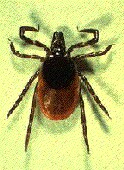
MONDAY, Nov. 12 (HealthDay News) — A tick-borne disease that causes symptoms similar to malaria is becoming more widespread in the northeastern United States, researchers say.
Babesiosis invades red blood cells and is carried by deer ticks, which also carry Lyme disease. Between 2000 and 2008, towns in Connecticut reporting cases of babesiosis increased from 30 to 85, according to the researchers.
Since babesiosis was first reported in Connecticut in 1991, cases in the state have risen from three to about 100 a year. Symptoms include fever, chills, fatigue, sweats, headache and muscle pain.
The study’s findings were scheduled to be presented Monday at the annual meeting of the American Society of Tropical Medicine and Hygiene, in Atlanta.
“Today’s findings underscore the shifting landscape of tick-borne diseases, whose rapid emergence can challenge the best efforts of science and medicine to diagnose, treat and prevent their occurrence,” Dr. Peter Krause, a researcher at the Yale School of Public Health in New Haven, Conn., said in a society news release.
The information about babesiosis was accompanied by discussions of other research into newly emerging tick-borne diseases, some of which can cause fatal encephalitis, an inflammation of the brain.
Dr. James Kazura, the society’s president, said this “is a real-time illustration of the inter-connectedness of human and animal health that many people don’t often think about.” Ticks carry many human diseases, he said, adding that “efforts like this offer timely information that is of regional and clinical importance.”
Lyme disease is the most common tick-borne disease in the United States, with 20,000 to 30,000 cases reported each year. But a growing number of diseases are carried by deer ticks and becoming more widespread in the United States, experts warned.
Data and conclusions presented at medical meetings are typically considered preliminary until published in a peer-reviewed medical journal.
More information
The U.S. National Institute of Allergy and Infectious Diseases has more about tick-borne diseases.

